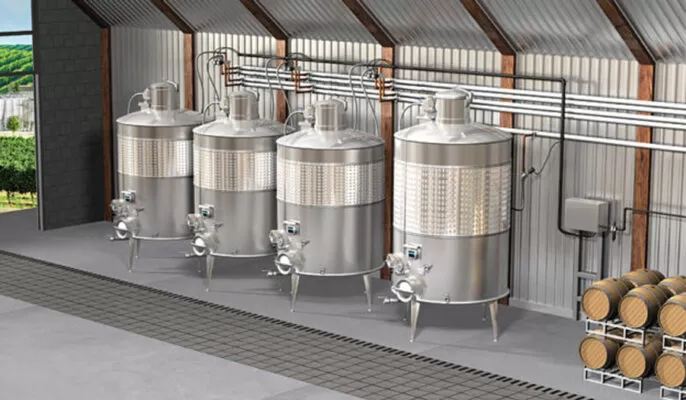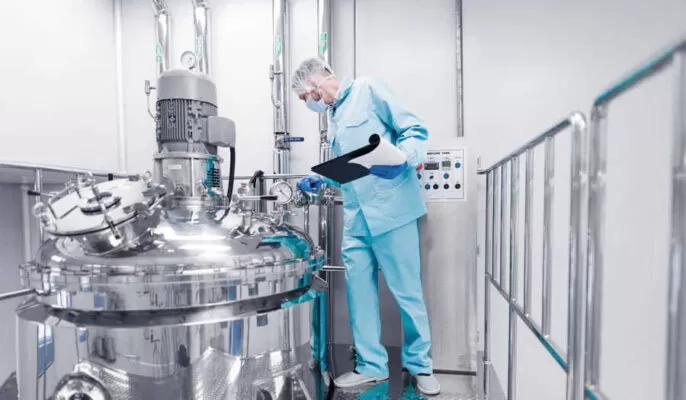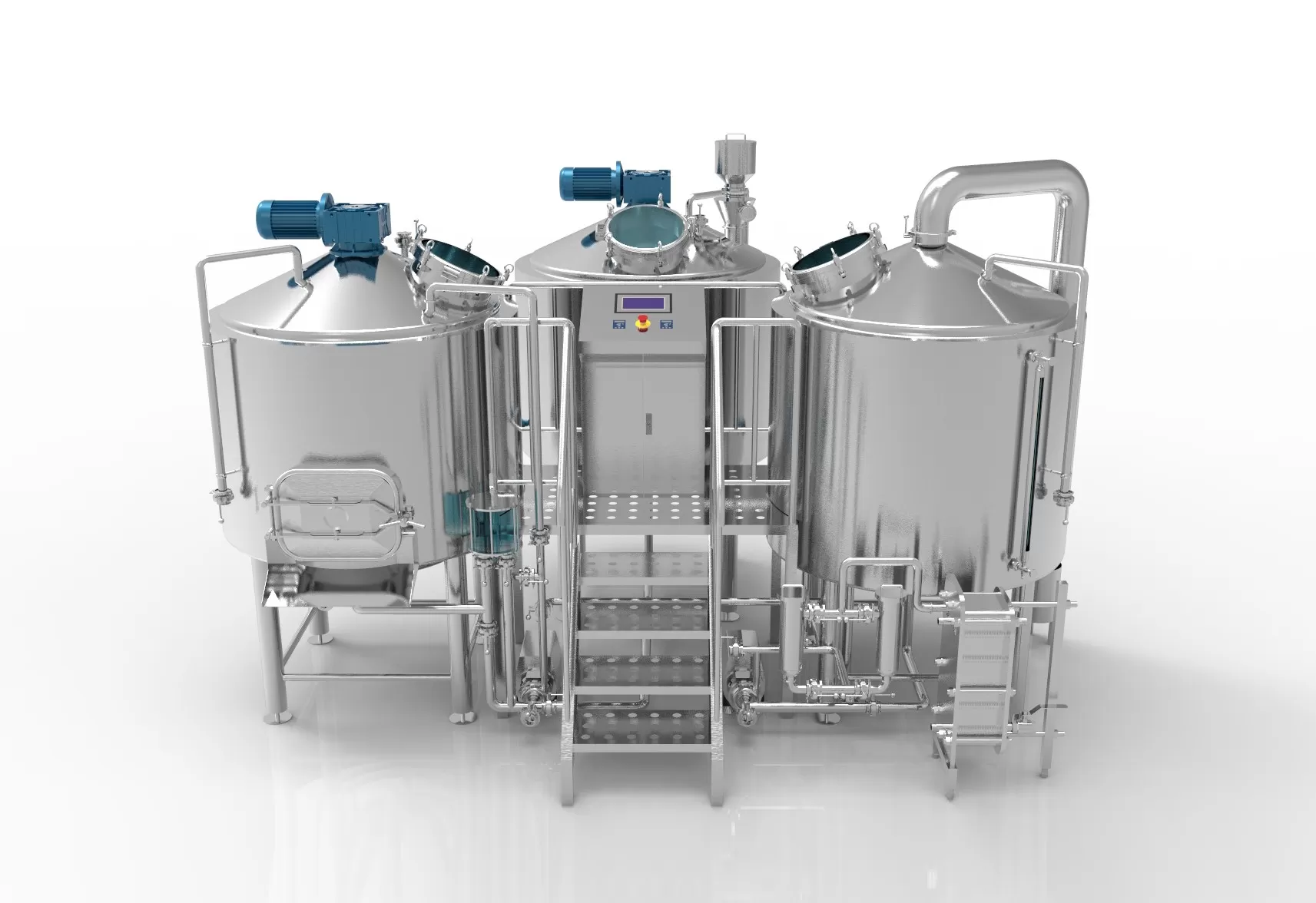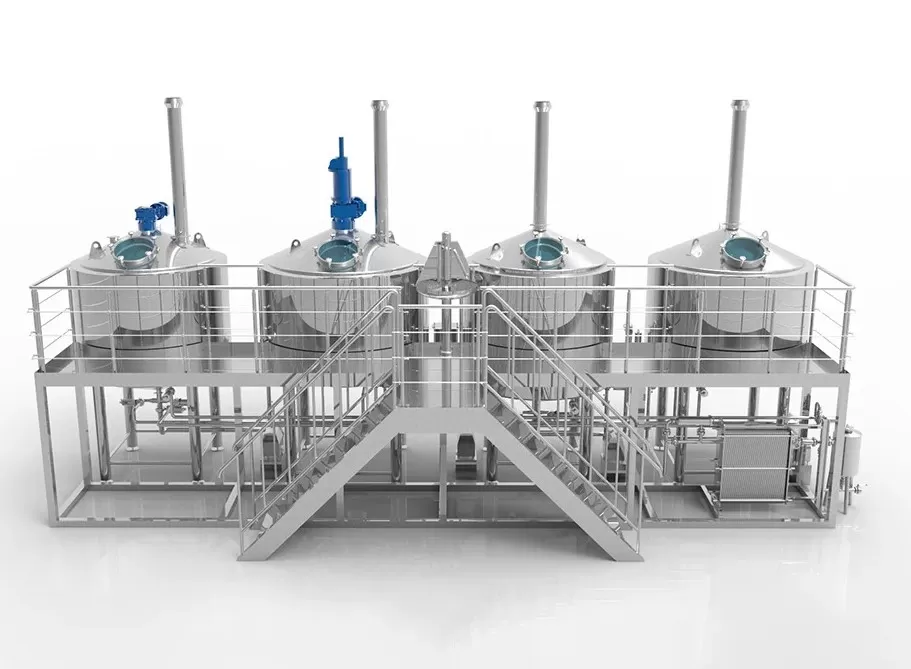Overview of 5bbl Beer Brewing Systems
5bbl beer brewing equipments are a popular size for micro and craft breweries looking to ramp up production from smaller pilot systems or homebrew kits. With a brewing capacity around 155 gallons (588 liters) per batch, 5bbl systems allow more beer output while still enabling the flexibility and experimentation that smaller breweries require.
This guide covers key considerations in 5bbl beer brewing equipment selection, from brew house and fermentation designs to boiler requirements, accessories, installation factors and more. Whether you are planning a new microbrewery or upgrading existing infrastructure, understanding 5bbl system characteristics will ensure you choose equipment optimized for your goals.
Table: Key Features of 5bbl beer brewing equipments
| Capacity per batch | Typically around 155 gallons (588 liters) |
| Batch frequency | 1-3 batches per day depending on schedules |
| Beer output | Around 3,000-9,000 barrels annually |
| Boiler size | 7-10 bbl steam boiler or gas-fired hot liquor tank |
| Brewhouse size | Takes up around 400-600 sq ft space |
| Tanks | Unitank or separate fermenter and brite tank designs |
| Popular with | Microbreweries, brewpubs, and taprooms |
| Cost range | Around $250,000-$500,000 depending on features |
Types of 5bbl Brewhouses
When selecting a 5bbl brewhouse, you’ll need to choose between traditional 3-vessel or more automated 2-vessel brewhouse designs.
Table: Comparing 3-Vessel and 2-Vessel 5bbl Brewhouses
| 3-Vessel Brewhouse | 2-Vessel Brewhouse |
|---|---|
| Contains mash tun, lauter tun, kettle | Combines mash and lauter tun into one vessel |
| More manual transferring of wort | Automated wort transfer |
| Lower equipment cost | Higher cost but more automated |
| More operator attention needed | Less labor for transfers |
| Simpler design and repairs | More integrated piping and controls |
While 3-vessel systems involve more hands-on work to move wort between vessels, they provide low-cost access to commercial scale batches. 2-vessel automated brewhouses streamline the process with pumps and pipes transferring wort, but have higher equipment expenses.
The choice depends on your budget, batch frequency, and desired level of automation. Larger breweries may favor the hands-off nature of 2-vessel systems since they brew more often.
Figure: Example of a manual 3-vessel 5bbl beer brewing equipment
A typical 3-vessel brewhouse contains a mash tun, lauter tun, and kettle with manual transfers of wort between vessels.
Figure: Example of an automated 2-vessel brewhouse
A 2-vessel brewhouse condenses the mash and lauter tuns and uses pumps to automatically move wort between vessels.

5bbl Brewing System Specifications
When purchasing equipment, you’ll need to define tank sizes, material types, automation features, and spatial requirements. Use the following to guide your 5bbl system specifications.
Table: 5bbl beer brewing equipment
| Vessel | Typical Size | Material Options |
|---|---|---|
| Mash tun | 6-8 bbl | Stainless steel, copper |
| Lauter tun | 6-8 bbl | Stainless steel, copper |
| Brew kettle | 7-10 bbl | Stainless steel |
| Whirlpool | Integrated in kettle or separate 5-10 bbl tank | Stainless steel |
- Mash tuns and lauter tuns are sized based on your target 5bbl batch size. Copper and stainless steel are common materials.
- The boil kettle should be slightly larger than the batch size. Stainless steel helps prevent reactions with wort.
- Whirlpools may be integrated into the boil kettle or use a separate tank for trub separation.
Table: 5bbl Brewhouse Automation & Controls
| Automation & Control Options | Benefits |
|---|---|
| Digital temperature controls | Precise temperature management during mashing and boiling |
| Variable speed drives on pumps | Flexible control over wort transfers |
| Automated valves for transfers | Reduce labor with automated opening/closing of valves |
| Sensors for tank levels and densities | Provide monitoring and help control automated equipment |
| Touchscreen control panels | Allow recipe programming and control of brewing parameters |
- Digital controls help dial in temperatures and maintain mash profiles. Variable frequency drives offer adjustable pump speeds.
- Automating valve opening/closing reduces the need for manual valve turning during transfers.
- Sensors add data for monitoring tank levels, wort densities, and help automate flows.
- Touchscreens give intuitive control and allow saving recipes. Look for easy to clean panels.
Table: 5bbl Brewhouse Sizing and Layout
| Sizing and Layout Factors | Typical Dimensions |
|---|---|
| Height | 7-12 ft ceilings to fit vessels |
| Floor space | Approx 400-600 sq ft |
| Service access | 3-4 ft around tanks for cleaning and maintenance |
| Floor slope | Sloped floor with drains simplifies cleaning |
| Utilities | prophet/gas, water, drains located near vessels |
| Grain handling | Designate space for grain storage and milling |
- A brewhouse will need high ceilings to accommodate tank heights. Expect to need 400-600 square feet.
- Leave clearance around tanks for cleaning and service access. Sloped floors simplify washdowns.
- Position utilities like steam, gas lines, water hoses, and drains near brewhouse vessels.
- Factor in space for grain storage and milling equipment. Mill should be near mash tun.
Table: Utilities and Installation Requirements
| Utility/Installation Needs | Typical Specifications |
|---|---|
| Electrical | 3 phase, 200-400A, 480VAC distribution panel |
| Plumbing | 2-3″ water lines, drains, glycol cooling lines |
| Steam | 7-10 bbl steam generator if needed |
| Compressed air | Air compressor and lines for pneumatics |
| Ventilation | Hoods over kettles, roof vents |
| Installation | Concrete foundation, floor coating |
| Commissioning | Supplier oversight of equipment calibration |
- A 480V 3-phase electrical supply with 200-400A capacity is typical.
- Water, drains, and cooling lines should be 2-3″ diameter to suit pumps.
- Some systems use steam boilers or direct fire gas systems instead of steam generators.
- Air compressors and lines are needed if using pneumatic valves or actuators.
- Provide hoods and roof vents for brewhouse ventilation.
- Concrete foundations and chemical resistant floor coatings are common.
- Have the supplier commission and calibrate the system.
Fermentation Tanks for 5bbl beer brewing equipments
You’ll also need fermentation and bright tanks appropriately sized for your batch volumes and schedule.
Table: Fermentation Tank Options for 5bbl beer brewing equipments
| Type | Specs | Benefits |
|---|---|---|
| Unitanks | Dual purpose fermenter and bright tank in one vessel | Compact footprint, flexible use |
| Separate tanks | Dedicated fermenters and brite tanks | Optimized for each purpose |
- Unitanks combine fermentation and beer clarifying into one tank for efficiency.
- Some brewers use dedicated fermenters and bright tanks for optimal conditions in each.
Table: Fermentation Tank Sizing
| Tank Volume | Use Case |
|---|---|
| 3-5 bbl | Smaller than brewhouse batch size allows staggered fermentation cycles |
| 7-10 bbl | Same as brewhouse size for synchronous fermentation |
| 12-20 bbl | Larger tanks enable higher capacity and seasonal fluctuations |
- Fermenters may be smaller than the brewhouse batch size to provide staging.
- Matching the brewhouse size synchronizes fermentation cycles.
- Larger tanks build in headroom for lagering or peak production periods.
Table: Fermentation Tank Specifications
| Specification | Details |
|---|---|
| Material | Stainless steel for durability and sanitation |
| Jacketed | Glycol or steam jackets to control temperature |
| Agitators | Impellers or rousing arms for yeast suspension |
| Sensors | Density, pH, temperature sensors for monitoring |
| Controls | Automated temperature and agitation programming |
| Connections | Sample valves, manways, CIP sprayballs, glycol or steam inlets |
- Stainless steel provides an impervious, sanitary surface for fermentation.
- Jacketing allows precise temperature control during fermentation.
- Agitators keep yeast in suspension and support healthy fermentation.
- Sensors help monitor ongoing fermentation progress.
- Automated controls dial in temperature profiles and agitation.
- Include sample ports, sprayballs, Temperature sensor connections.
Table: Fermentation Cellar Design Factors
| Design Factor | Guidelines |
|---|---|
| Tank height | 7-10 ft typical from cellar floor to top of tank |
| Spacing | 2-3 ft between tanks and walls for access |
| Flooring | Sealed concrete or epoxy coating |
| Drainage | Sloped floor to drains |
| Cooling | Glycol chiller unit sized for tank volume |
| Ventilation | Air exchange rates appropriate for cellar design |
- Allow for sufficient cellar height and spacing around tanks for access.
- Sealed concrete or epoxy floors simplify cleaning and drainage.
- Install glycol chiller systems for fermentation temperature control.
- Provide adequate air exchanges to control humidity and temperature.
Boiler Systems for 5bbl beer brewing equipment
The brewhouse boiler provides hot water and steam to heat wort to boiling and maintain mash temperatures.
Table: Boiler System Options for 5bbl Brewing
| Type | Details | Benefits |
|---|---|---|
| Steam boiler | 7-10 bbl firetube or coil boiler | Efficient, powerful steam supply |
| Gas-fired hot liquor tank | 300-500 gallon indirect hot water tank | Compact, lower cost |
- Steam boilers offer high energy steam but require more space and maintenance. Popular for repeated batches.
- Hot liquor tanks use direct gas firing for hot water with a smaller footprint but slower heating.
Table: Key Boiler Specifications
| Parameter | Typical values |
|---|---|
| Steam boiler output | 150-200 boiler HP |
| Hot water output | 500,000-1 million BTU/hr |
| Steam pressure | Up to 15 psi maximum |
| Hot water temperature | Up to 195°F |
| Fuel source | Natural gas, propane |
- Look for 150-200 boiler horsepower steam boilers or 500,000-1 million BTU gas hot liquor tanks.
- Steam pressure should reach around 15 psi maximum.
- Target 195°F hot water temperature for mashing.
- Fuel with natural gas or propane depending on availability.
Table: Boiler Installation Requirements
| Item | Considerations |
|---|---|
| Ventilation | Stainless steel flue sized for boiler capacity |
| Gas supply | 1-2″ gas line with sufficient BTU capacity |
| Water | Feedwater treatment system to condition water |
| Controls | Automated blowdown valves, level sensors |
| Location | Within 50 ft of brewhouse |
- Stainless steel flue should remove exhaust and sized for boiler CFM capacity.
- Ensure gas line sizing suits the boiler BTU rating.
- Treat feedwater to remove minerals and prolong boiler life.
- Automate blowdown and monitor water level.
- Position near the brewhouse for efficient steam distribution.

Additional Equipment for 5bbl beer brewing equipments
Supplement your core brewhouse, fermentation, and boiler equipment with these additional accessories and infrastructure.
Table: Cleaning and Sanitation Equipment
| Item | Details |
|---|---|
| CIP skid | Tank and pump skid to deliver hot cleaning solutions from a central station |
| Sprayballs | Rotate to clean interior of tanks |
| Heat exchanger | Uses hot water or steam to sanitize solution before spraying tanks |
| Foamers | Applies foaming caustic and acid solutions to exterior of tanks |
- A CIP skid pumps heated cleaning solutions from a central station to each tank.
- Sprayballs rotate to clean interiors. Exterior foamers cover outside surfaces.
- Heat exchangers ensure proper sanitizing solution temperatures.
Table: Additional Brewhouse Equipment
| Item | Purpose |
|---|---|
| Grist case | Holds milled grain above mash tun |
| Grist hydrator | Wets grist before adding to mash tun to prevent dough balls |
| Mash paddle | Stirs mash to evenly hydrate grain particles |
| Grant | Collects wort from lauter tun before pumping to kettle |
| Whirlpool stand | Supports a whirlpool tank above the boil kettle |
- Grist cases hold milled grain. Grist hydrators wet grist before mashing in.
- Mash paddles evenly mix grain and water. Grants collect wort between vessels.
- Whirlpool stands allow installing a whirlpool tank overhead.
Table: Fermentation Accessories
| Item | Purpose |
|---|---|
| Glycol chiller | Cools glycol used in jackets to control fermentation temperature |
| Aeration stone | Oxygenates wort prior to pitching yeast |
| CO2 system | Carbons fermented beer and pushes it from tanks |
| Lees filter | Removes yeast and hop particles when transferring beer |
- Glycol chillers provide fermentation temperature control.
- An aeration stone oxygenates wort to improve yeast health.
- Use CO2 to carbonate and transfer finished beer, and a lees filter to clarify.
Table: Infrastructure and Utilities
| Item | Purpose |
|---|---|
| Grain handling | Receiving, milling, storing grain |
| Ingredient station | Scales and containers for weighing out hop additions |
| Chillers | Glycol or refrigerant-based system to provide process cooling |
| Water treatment | Filters and softeners to condition brewing liquor |
| Wastewater | Clarifier or filtration to remove solids before draining |
| Building insulation | Maintain stable brewing temperatures year-round |
- Proper grain handling involves receiving, milling, and storing.
- Use scales to accurately weigh out hop additions.
- Install industrial chillers for wort cooling and glycol systems.
- Treat water to remove chlorine and minerals that affect brewing.
- Wastewater may need filtering to catch spent grains and trub.
- Insulate warehouse spaces to prevent temperature swings.
5bbl Brewing Equipment Suppliers
There is a wide range of equipment manufacturers and suppliers to choose from when purchasing 5bbl beer brewing equipments.
Table: Leading 5bbl beer brewing equipment Suppliers
| Company | Locations | Product Lines |
|---|---|---|
| Specific Mechanical | Canada, USA | brewhouses, fermentation, steam boilers |
| JV Northwest | USA | brewhouses, fermentation, controls |
| Premier Stainless | USA | manual and automated brewhouses, tanks |
| Russell Hendrix | USA | brewhouses, tanks, steam systems |
| ABS Commercial | Italy, USA | brewhouses, fermentation, water treatment |
- Specific Mechanical offers an end-to-end brewhouse, fermentation, and boiler product line made in North America.
- JV Northwest focuses on brewhouses and integrated control systems.
- Premier Stainless provides brewhouses from manual 3-vessel to automated options with fermentation.
- Russell Hendrix carries a range of brewhouses, tanks, and steam equipment made in the USA.
- ABS Commercial builds brewhouses and fermentation in Italy and the US with water treatment systems.
When requesting quotes, provide key parameters like batch size, degree of automation, number of fermentation tanks, utility requirements and budget. Get multiple bids to compare options.
Table: Estimated Cost Ranges for 5bbl beer brewing equipment
| Equipment | Cost Range |
|---|---|
| 3-vessel brewhouse | $50000 – $75000 |
| 2-vessel brewhouse | $40000 – $60000 |
| Fermentation tanks | $3000 – $4000 bbl |
| Steam boiler | $4000 – $4500 installed |
| Grain handling and mill | $1500 – $3500 |
| Glycol chiller | $3000 – $5000 |
| TOTAL | Around $55000-$100000 |
Purchasing Considerations for 5bbl beer brewing equipments
Follow this criteria when evaluating and selecting equipment to get the best system for your needs.
Table: Key Decision Factors for 5bbl Brewing Equipment
| Factor | Guidelines |
|---|---|
| Quality | Choose equipment built with durable, food-grade materials from reputable suppliers. |
| Degree of automation | Evaluate the level of manual vs automated transfers and controls needed for your workflows. |
| Flexibility | Seek modular systems allowing for reconfiguration as your production evolves. |
| Usability | Ensure pumps, valves, controls are ergonomic and user-friendly. |
| Maintenance | Review ease of access for cleaning and routine maintenance. |
| Expansion capability | Consider systems that can integrate with larger fermentation tanks, additional brewhouse vessels, etc as you grow. |
| Price | Compare pricing quotes and financing options across suppliers for the best value. |
| Lead time | Ask about equipment availability and project timelines. |
| Warranty and service | Verify warranty terms and local availability of technical support. |
| Supplier experience | Choose an experienced brewery equipment vendor with past 5bbl projects. |
- Prioritize quality components from reputable suppliers suited for commercial brewing.
- Find the right balance of manual and automated features for your needs.
- Seek modular, reconfigurable systems to allow for changes down the road.
- Review ease of use and maintenance access to tanks, pumps, controls.
- Evaluate flexibility for incremental upgrades and expansion capabilities.
- Compare pricing and financing options to find the best deal.
- Confirm lead times, warranty terms, and service availability.
- Select an experienced vendor who can properly install and commission the system.
Installation and Commissioning of 5bbl beer brewing equipments
Proper installation and commissioning ensures your equipment operates safely and efficiently.
Table: 5bbl System Installation Steps
| Task | Description |
|---|---|
| Site prep | Pour concrete foundations to specifications, run electrical/plumbing to equipment locations. |
| Equipment delivery | Schedule delivery once foundations and utilities are ready. |
| Equipment positioning | Unload vessels and place onto foundations. |
| Utility connections | Connect plumbing, gas, glycol, compressed air, and electrical to equipment. |
| Controls integration | Wire vessels, pumps, sensors to control panels and test connectivity. |
| Calibration | Have supplier calibrate temperature sensors, metering, pumps, etc for accuracy. |
| Test batch | Brew a test batch observing equipment operation before starting regular production. |
| Training | Review operating and cleaning procedures with brewery staff. |
| Documentation | Obtain equipment manuals, schematics, warranties, and contact info. |
- Start by preparing the site with poured foundations and roughed in utilities.
- Have equipment delivered once foundations and connections are ready.
- Carefully position and secure vessels onto foundations.
- Connect all plumbing, gas, electrical, glycol etc to equipment.
- Integrate controls and test for proper operation. Calibrate sensors and metering.
- Perform a test batch while observing equipment function before full production.
- Review training manuals and operating procedures with brewery staff.
- Obtain equipment documentation like manuals, drawings, warranties.
Proper installation by qualified technicians ensures your 5bbl beer brewing equipment operates reliably for years to come. Take the time to ramp up production gradually while monitoring equipment performance closely.
Operating a 5bbl Brewhouse
Follow safe standard operating procedures for efficient beer production.
Table: 5bbl Brewhouse Operation
| Phase | Procedure |
|---|---|
| Mash-in | Measure strike water volume and temperature and add grist per recipe. Monitor mash temperature profile. |
| Lautering | Recirculate wort to clarify. Run off wort to kettle at proper clarity. |
| Boil | Time hop additions per recipe. Monitor boil gravity and temperatures. |
| Whirlpool | Engage whirlpool arm or pump. Allow debris to settle before draining clear wort. |
| Cleaning | Clean vessels immediately after use. Follow CIP procedures with proper chemicals and temperatures. |
- Closely follow the mash temperature profile by monitoring and adjusting heating.
- During lautering, recirculate until wort is clear before transferring to the kettle.
- Add hops, monitor gravities and temperatures during the boil per recipe.
- Whirlpool to separate hops and coagulate proteins after boiling.
- Start CIP while vessels are still hot after brewing for effective cleaning.
Table: Fermentation Operation
| Phase | Procedure |
|---|---|
| Yeast pitch | Aerate wort to 8-10 ppm oxygen before pitching. |
| Fermentation | Maintain proper temperature profile. Monitor gravity daily. |
| Dry hopping | Add dry hop charge at right time and temperature if used. |
| Transfer | Send to brite tank after final gravity is reached and yeast settles. |
| Carbonation | Inject CO2 for natural carbonation at desired volumes. |
- Oxygenate cooled wort before pitching yeast.
- Hold fermentation temperature per recipe. Check gravities to confirm complete fermentation.
- Introduce dry hop additions if used after primary fermentation subsides.
- Carefully transfer beer to brite tank once final gravity is reached.
- Carbonate to target CO2 volumes by spunding with CO2.
Consistent routine operation and cleaning will maximize beer quality and minimize losses. Keep detailed brewing logs of all parameters and batches.
Maintenance for 5bbl beer brewing equipments
Regular maintenance prevents unexpected downtime and ensures consistent beer quality.
Table: Recommended Maintenance Schedule
| Frequency | Tasks |
|---|---|
| Daily | Calibrate sensors, inspect vessels, log readings |
| Weekly | Test safety relief valves, lubricate pumps, inspect steam traps |
| Monthly | Inspect electrical terminations, test glycol pH, check belt tensions |
| Quarterly | Verify valve seal integrity, inspect hoses, review water tests |
| Annual | Complete brewhouse inspection, tank inspection, boiler descale |
- Perform daily inspections of vessels, pumps, sensors. Log all parameters.
- Test safety relief valves and inspect steam traps weekly for proper function.
- Check electrical, glycol, and mechanical monthly. Adjust belts as needed.
- Every quarter inspect valves, hoses, and review water chemical tests.
- Do a thorough annual inspection and tune-up of the entire system.
Table: Preventative Maintenance
| System | Tasks |
|---|---|
| Pumps | Lubricate, inspect seals, replace worn parts |
| Gaskets | Replace worn gaskets on vessels and piping |
| Valves | Inspect valve seats and seals. Rebuild as needed. |
| Sensors | Calibrate temperature and density meters. Replace aging probes. |
| Steam traps | Inspect for leakage. Repair or replace faulty traps. |
| Boiler | Test blowdown valves, clean fireside and waterside annually |
- Keep pumps lubricated and replace worn seals, bearings, and other parts.
- Change out any leaking gaskets to prevent contamination.
- Inspect valve seats and seals. Rebuild or replace worn valves.
- Calibrate sensors regularly for accuracy. Replace aging probes.
- Fix any leaking steam traps to ensure efficient steam use.
- Service boiler waterside, fireside, blowdown valves annually.
Maintain detailed records of all preventative maintenance and repairs. A well maintained 5bbl beer brewing equipment will provide years of consistent brewing.

FAQ
| Question | Answer |
|---|---|
| How much beer can a 5bbl system produce annually? | Around 3,000-9,000 barrels depending on schedule. |
| What size boiler is needed? | 7-10 bbl steam boiler or 500,000 BTU gas hot liquor tank. |
| How much space does a 5bbl brewhouse require? | Typically 400-600 sq ft for the vessels and boiler. |
| How many fermenters are ideal? | A minimum of 3-4 tanks allows overlapping brews. |
| What are the electrical requirements? | 200-400 amps, 480VAC 3-phase service. |
| What installation is required? | Poured concrete foundations, plumbing, steam, electrical, glycol. |
| What kind of training is needed? | 2-3 weeks of onsite training covering operations and maintenance. |
| What is the breakeven batch number for cost recovery? | Around 150-300 batches depending on production schedule. |
| What are ongoing maintenance costs? | Figure around 5% of system cost annually in maintenance and parts. |
| What are the biggest challenges with 5bbl systems? | Consistency, quality control, cleaning, maintenance schedules. |
- A 5bbl system can produce around 3,000-9,000 barrels annually depending on brewing schedule.
- Look for a 7-10 bbl steam boiler or 500,000 BTU gas hot liquor tank.
- Allow 400-600 square feet for the brewhouse and boiler room.
- Have at least 3-4 fermentation tanks for overlapping brew cycles.
- Require a 200-400 amp, 480VAC 3-phase electrical supply.
- Install foundations, plumbing, steam, glycol, and electrical hookups.
- Plan on 2-3 weeks of onsite training for brewers on operations and maintenance.
- Estimate around 150-300 batches to recoup equipment costs depending on production.
- Budget approximately 5% of system cost annually for maintenance parts and service.
- Biggest challenges are consistency, quality control, cleaning practices, and maintenance.
Careful planning and selection of your 5bbl system along with focus on training and procedures will set your brewery up for success.




